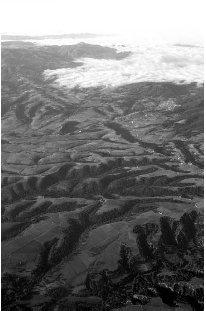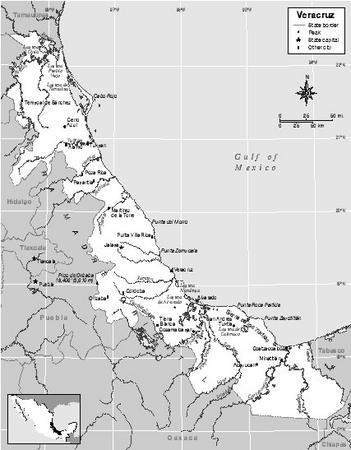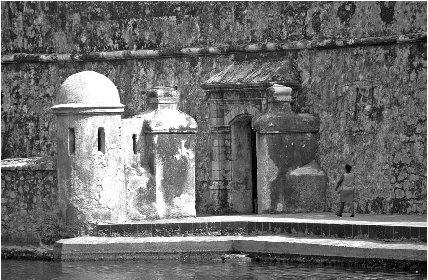Veracruz

Pronunciation: vair-ah-KROOS
Origin of state name: Spanish explorer Hernán Cortés (1485-1547) landed at Chalchihuecan in Veracruz on April 22, 1519, which was Good Friday, the Friday before Easter. Good Friday is also known as Vera Cruz (True Cross). Cortés called the settlement Villa Rica de la Vera Cruz.
Capital: Jalapa (hah-LAH-pah); sometimes spelled Xalapa
Entered country: October 3, 1824
Coat of Arms: A red cross at the top is inscribed with the word vera (cross), representing the name of the state. The castle represents the original settlement of Villa de La Vera Cruz. It is supported by the Columns of Hercules, which are also found on the Spanish coat of arms. The blue field represents the ocean. The columns and the blue field represent the fact that the original colony belonged to Spain, even though it was located across the Atlantic Ocean.
Holidays: Año Nuevo (New Year's Day—January 1); Día de la Constitución (Constitution Day—February 5); Benito Juárez's birthday (March 21); Primero de Mayo (Labor Day—May 1); Revolution Day, 1910 (November 20); and Navidad (Christmas—December 25).
Flag: There is no official state flag.
Time: 6 AM = noon Greenwich Mean Time (GMT).
1 Location and Size
Veracruz is located in eastern Mexico in a region known as the Oil Basin and Gulf Lowlands. It is bordered on the north by the Mexican state of Tamaulipas; on the south by the Mexican states of Oaxaca, Chiapas, and Tabasco; on the east by the Gulf of Mexico; and on the west by the Mexican states of San Luis Potosí, Hidalgo, and Puebla. Veracruz covers an area of 72,815 square kilometers (28,114 square miles), which is about half the size of the US state of Illinois. The state is divided into 210 municipalities. The capital is Jalapa.
There are coastal plains along the coast of the Gulf of Mexico. Beyond the coastal plains, hills and canyons are found. Further inland there is the Sierra Madre Oriental, which has different names according to the region it occupies: Sierra de Huayacocotla, Zomelahuacan, Chiconquiaco, Huatusco,

An aerial view of Veracruz.
The highest mountains in the state are the Pico de Orizaba (5,610 meters/18,500 feet above sea level) and the Cofre de Perote (4,200 meters/13,860 feet).
The most important rivers in Veracruz include the Pánuco, Tuxpan, and Cazones Rivers in the north; the Tecolutla, Actopan, La Antigua, Jamapa, Nautla, and Blanco Rivers in the central region; and the Papaloapan, Coatzacoalcos, and Tonalá Rivers in the south.
2 Climate
The warm waters of the Gulf of Mexico contribute to the climate, which is generally warm and humid. The average temperature is 24° c to 28° c (76° f to 82° f ). The highest monthly average rainfall occurs in August and September. Average rainfall in the city of Veracruz is about 173 centimeters (68.3 inches) per year. In Coatzacoalcos, the average rainfall is about 261 centimeters (102 inches) per year.
3 Plants and Animals
Cedar, mahogany, and ceiba trees are found in several regions of the country. Palm trees and mangroves grow in coastal regions. In the city of Papantla, vanilla pods are harvested from an orchid-type plant called tlixochitl. Wild boar, coyotes, ocelots, spider monkeys, and pumas live in various parts of the state. Iguanas and manatees are found in coastal regions. Alligators live in the Tuxtlas region. Birds found in the state include toucans, owls, woodpeckers, and buzzards.
4 Environmental Protection
The Sierra de los Tuxtlas ecoregion contains one of the largest moist forests in Mexico. Many plant and animal species found are unique to Mexico and cannot be found anywhere else in the world. The ecosystem includes seven volcanoes and several lakes, lagoons, and marshlands.
5 Population, Ethnic Groups, Languages
Veracruz had a total population of

Almost all citizens speak Spanish as their first language. About 10.4% of the state population speaks indigenous (native) languages, which is higher than the national average of about 7%.
6 Religions
According to the 2000 census, 73% of the population, or five million people, were Roman Catholic; 6%, or 422,973 people, were Protestant. That year there were also 80,266 Seventh-Day Adventists, 18,581 Mormons, 102,346 Jehovah's Witnesses, and 1,334 Jews. Over 410,000 people reported no religion.
7 Transportation
Poza Rica Airport and Tehuacán Airport provide international flights to and from Veracruz-Llave airport in the city of Veracruz Llave. The state has about 10,727 kilometers (6,663 miles) of roads and about 1,176 kilometers (730 miles) of railroads. The three major ports are at Coatzacoalcos, Alvarado, and Tuxpan.
8 History
Three important pre-Spanish civilizations evolved in this vast and extended coastal state. They were the Huasteca in the northern region, the Totonac culture in the middle region, and the late Olmec culture in southern Veracruz. The Triple Alliance formed in central Mexico, which included the Aztecs in Mexico-Tenochtitlan, the Texcoco, and the Tacuba, who dominated the entire Veracruz region at the beginning of the 15th century. They levied taxes on the numerous sedentary agricultural villages of the region.
The first Spaniards to arrive in Veracruz were under the command of Juan de Grijalva (c. 1489–1527) in 1518. Other members of the expedition were Pedro de Alvarado, Francisco de Montejo, and Bernal Diaz del Castillo, who later became a champion of indigenous rights. A second expedition, motivated by the presence of gold detected by the first expedition, was sent in 1519 under the command of Hernán Cortés (1485–1547). Cortés founded the city of Vera Cruz where he disembarked. Cortés and his lieutenant, Gonzalo Sandoval, overpowered an initial Huasteca rebellion. Because of the oppression by the Triple Alliance, the Totonac readily joined Hernán Cortés when he disembarked in Veracruz with the intention of defeating the Aztecs in their capital, Tenochtitlan (now Mexico City).
During the first years after the Spanish arrived, diseases brought by the Europeans and unknown to the indigenous people decimated the population. This devastation was helped by the massive enslavement to which most village inhabitants were subjected after being conquered. Sugarcane production made heavy demands on indigenous labor. As the indigenous population decreased, African slaves were brought to work in the plantations. The port city of Veracruz became the most important port of entry for all of Mexico. In 1601, the city was relocated to its present position. Several attacks by pirates in the 17th century demonstrated the economic and military importance of Veracruz for the Spanish crown. Massive slave trade converted Veracruz into the city with the largest enslaved population in Mexico. A

This Veracruz fort was the setting for the 1984 film, Romancing the Stone.
Several insurgency efforts against Spanish rule surfaced after 1810, with Guadalupe Victoria (1789–1843) emerging as the most important independence leader in the region. When the Plan of Iguala came into effect in 1821, securing independence for the entire country of Mexico, the insurgent leader in Veracruz was Antonio López de Santa Anna (1794–1876). López de Santa Anna would become the most important military leader of Mexico during the 19th century. The on and off president allied with conservative and liberal leaders alike with the sole objective of retaining power. Santa Anna lost the Mexican-American War (1846–48) and negotiated the Treaty of Guadalupe, where Mexico ceded large amounts of land to the United States. Veracruz became a federal state in 1824. A new state constitution was created in 1825.
Veracruz, as with the rest of Mexico, experienced political and social instability during much of the 19th century. Conflicts between centralists and federalists and between liberals and conservatives hindered economic development and provoked continuous revolts. Mexican president Benito Juárez (1806–1872) governed from Veracruz when his liberal government was attacked in Mexico City in 1857. A few years later, French emperor Maximilian (1832–1867) arrived in Veracruz in 1863 to assume the position of emperor of Mexico. (France had conquered and ruled parts of Mexico from 1864 to 1866.)
During the Mexican Revolution (1910–1920), Veracruz became a battleground for different factions. With the end of the revolution, its victors brought peace and stability to the region, which has consolidated as one of the most populated and economically active states of the Mexican union.
9 State and Local Government
The state governor is democratically elected for a six-year nonrenewable term. There is a unicameral (single chamber) legislature whose deputies are elected for nonrenewable three-year terms. Some deputies are elected both in single member districts and some deputies are elected at large. There can be no more than 60 deputies in total. Although the Institutional Revolutionary Party (PRI), the most powerful political party in the country since the end of the Mexican Revolution, historically exercised tight control over the state government, the rise of the National Action Party (PAN) and the Party of the Democratic Revolution (PRD) in large urban areas has made state politics more competitive. Formal separation of powers established in the constitution has been more effectively enforced since opposition parties have successfully won enough seats in the legislature to block unilateral actions by the PRI.
The 212 municipalities that comprise Veracruz hold democratic elections for municipal presidents and council members every three years. Immediate re-election is not allowed. The widely different sizes and wealth of the municipalities in the state makes it difficult for decentralization initiatives to work well across the state.
10 Political Parties
The three main political parties in all of Mexico are the Institutional Revolutionary Party (PRI), the National Action Party (PAN), and the Party of the Democratic Revolution (PRD). The PRI has continued to dominate politics at the state level. Two former state governors went on to become presidents of Mexico, Miguel Alemán Valdés (president from 1946 to 1952) and Adolfo Ruiz Cortines (president from 1952 to 1958). Longtime influential PRI leader, Fernando Gutierrez Barrios, was governor of the state between 1986 and 1988. The PAN and PRD have successfully won municipal races in local elections, but the PRI's strength in rural areas allows that party to remain the dominant force in the state.
11 Judicial System
The Superior Tribunal of Justice is the highest court in the state. The governor appoints its sixteen members for three-year terms with the approval of the legislature. If justices are ratified after their first term, they serve indefinitely. Only highly qualified attorneys can be appointed to the Superior Tribunal. Justices cannot publicly participate in any religious creed. In addition, there is an electoral court and a number of lower courts distributed throughout this large state.
12 Economy
Manufacturing accounts for about 20% of the state economy. Service-based companies account for about 18% of the economy, followed by trade activities at 17%, finance and insurance at 17%, transportation and communications at 10%, agriculture and livestock at 10%, construction at 6%, and mining at 2%.
13 Industry
Veracruz is one of the most important oil producing regions in the country. The Coatzacoalcos-Miniatitlan petrochemical plant is one of the state's most important industrial facilities. Other industrial centers can be found in Córdoba and Orizaba. Textile manufacturing is important in Rio Blanco.
14 Labor
The U.S. Bureau of Labor Statistics reported that Mexican workers saw their wages increase 17%, from $2.09 per hour in 1999 to $2.46 per hour in 2000. (The average US worker earned $19.86 per hour in 2000.) After one year, workers are entitled by law to six days paid vacation.
15 Agriculture
The most important agriculture crops in the state are corn, sugarcane, citrus fruits, and tobacco. Coffee is an important crop in the areas surrounding the capital city of Jalapa. Cattle, pigs, goats, and sheep are the main livestock animals. Poultry and bees are also raised.
16 Natural Resources
Oil is the most important natural resource in the state.
17 Energy and Power
Almost all of the energy in Mexico is provided by the Federal Electricity Commission (CFE). There is only one nuclear power plant in the country. It is located in Laguna Verde; its first reactor began operation in April 1989 and the second in November 1994. Laguna Verde generates over 5% of Mexico's total electricity output. In February 2002, the CFE introduced new electric rates. For households that use less than 140 kilowatt hours per month, there was no rate increase. (This is about 75% of all households in Mexico, according to CFE). After the rate increases in 2002, Veracruz residents were charged higher rates because they use more than the minimum amount of electricity.
18 Health
The state of Veracruz has 77 general hospitals, 1,515 outpatient centers, and 182 surgical centers. There is also an American hospital in the city of Jalapa.
Most of the Mexican population is covered under a government health plan. The IMSS (Instituto Mexicano de Seguro Social) covers the general population. The ISSSTE (Instituto de Seguridad y Servicios Sociales de Trabajadores del Estado) covers state workers.
19 Housing
Less than one-half of the housing available in the state of Veracruz is in good repair. More than 30% is in need of significant upgrading. Many homes do not have running water or access to electricity.
20 Education
The system of public education was first started by President Benito Juárez in 1867. Public education in Mexico is free for students from ages six to sixteen. According to the 2000 census, there were approximately 1.6 million school-age students in the state. Many students elect to go to private schools. The thirty-one states of Mexico all have at least one state university. The Universidad Veracruzana is located in the capital, Jalapa.
21 Arts
The state of Veracruz has fourteen theaters. The Universidad de Veracruz hosts the Ballet Folklórico de Veracruz. There are four local musical groups including an orchestra of popular music. The Groupo Chuchumbe performs a traditional fandango (a Spanish dance that is usually performed by a couple to the accompaniment of guitars and castanets), while the Groupo Mono Blanco plays traditional music from the south of Veracruz. Veracruz has two theater groups, one of which is located at the University of Veracruz.
22 Libraries and Museums
The state of Veracruz has 453 branches of the national library system. There are also thirty-seven museums. In Córdoba there is a museum of whimsical art and an archeological museum. In Texistepec there is a museum of the ancient city of Tenochtitlan. In the city of Tuxpan there is a museum dedicated to the friendship between Cuba and Mexico. The capital city of Veracruz has a local history museum. Jalapa has a museum of science and technology, a museum of local animal life, and a museum of anthropology.
23 Media
Five cities publish newspapers in the state of Veracruz. Coatzacoalcos has two daily papers: Diario del Istmo and Diario Liberal del Sur. Córdoba has El Sol del Centro. Veracruz has two daily newspapers: El Dictamén and Negocios de Veracruz. The city of Jalapa (Xalapa) publishes Diario de Xalapa.
24 Tourism, Travel, and Recreation
Veracruz is noted for its beautiful beaches. The Chacalacas sandbar (about 35 miles along the coast) features many aquatic sports. There is also an aquarium in the city of Veracruz. Veracruz is famous for its Carnival (like Mardi Gras). The city of Jalapa has a museum of anthropology housing over 25,000 artifacts. The Xalapeno Stadium is known for its unique architectural design. The Botanical Gardens and the Paseo de Los Lagos are other attractions.
25 Sports
Jalapa's basketball team is the Halcones. Córdoba also has a professional baseball team, the Cafeteros de Córdoba, which plays in the 8,000-seat Estadio Beisborama 72. The city of Veracruz has a soccer team that plays in the 43,154-seat Luis Pirata Fuentes stadium. Veracruz's baseball team, Rojos de Aguila, plays in the 7,782-seat Beta Avila stadium. The city of Orizaba has a soccer team, which plays in the 7,000-seat Plaza de Toros stadium.
26 Famous People
Guadalupe Victoria (1789–1843) was an important leader in the region that is now Veracruz. Political and military figures from Veracruz include Antonio López de Santa Anna (1794–1876) and Ignacio de la Llave, who was governor of Veracruz state from 1857 to 1860. Two former state governors went on to become presidents of Mexico: Miguel Alemán Valdés (president from 1946 to 1952) and Adolfo Ruiz Cortines (president from 1952 to 1958) . Fernando Gutiérrez Barrios , a long-time PRI leader, was governor of Veracruz from 1986 to 1988. Miguel Alemán Velazco , son of Miguel Alemán Valdés, took office as governor of Veracruz in 1998.
27 Bibliography
Books
DeAngelis, Gina. Mexico. Mankato, MN: Blue Earth Books, 2003.
Supples, Kevin. Mexico. Washington, DC: National Geographic Society, 2002.
Web Sites
Mexico for Kids. http://www.elbalero.gob.mx/index_kids.html (accessed on June 15, 2004).
Surfing & Adventure Travel in Mexico: The State of Veracruz. http://www.surf-mexico.com/states/veracruz/index.html (accessed June 17, 2004).
A wonderful city everyone should visit someday!
PROUD TO BE MEXICAN!
THIS HAS MADE THIS PLACE SO ATTRACTIVE, THE GOVT. HAS GIVEN GREAT IMPORTANCE IN PRESERVING THE HISTORIC MONUMENTS.
EVEN IF YOU DON'T KNOW THE LOCAL LANGUAGE, VERACRUZ WELCOMES YOU WITH OPEN ARMS.